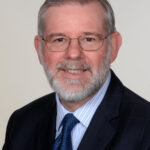Summary
On a December morning, a 62-year-old goes for a walk. There’s snow on the ground and she loses her balance. She falls and fractures her wrist. This simple fracture reveals underlying osteoporosis, requiring lifelong (and expensive) medication. But as you’ll learn from Dr. Richard Eastell, an endocrinologist and professor of Bone Metabolism at the University of Sheffield, this is where biosimilars come in. Biosimilars are extremely similar — hence the name — to the original biological drug they’re designed to imitate. The excitement around biosimilars is that they’re cheaper, making them more accessible to more people, meaning fewer fractures … better health … a better economy … and ultimately, a better quality of life.

Richard Eastell BSc (Hons), MBChB, MD (Edin), FRCP (London, Edin), FRCPI (Hon), FRCPath, FMedSci, Professor of Bone Metabolism and Director of the Mellanby Centre for Musculoskeletal Research at the University of Sheffield.
Dr. Richard Eastell qualified in medicine from Edinburgh in 1977. He trained in endocrinology in Edinburgh, Northwick Park and at the Mayo Clinic (Dr B L Riggs). He leads a research group on the pathogenesis, diagnosis and treatment of osteoporosis; of particular note is his contribution to the use of bone turnover markers and the development of treatments for osteoporosis. He was Secretary and President of the Bone Research Society and the European Calcified Tissue Society. He is an NIHR Senior Investigator (Emeritus). His work has been recognised by the Philippe Bordier Award (2012) (European Calcified Tissue Society), Frederic C Bartter Award 2014 and William F Neuman Award 2023 (American Society for Bone and Mineral Research), Kohn and Linda Edwards Awards from the Royal Osteoporosis Society (2004, 2018), the Clinical Endocrinology Trust Award from the European Society for Endocrinology (2020) and the Dent Lecturer from the Bone Research Society (2021).
Transcript
DDx SEASON 10, EPISODE 1
Biosimilars and the Quiet Revolution in Medicine
Dr. Raj Bhardwaj: This episode of DDX was produced in partnership with the American Society for Bone and Mineral Research, and sponsored by Sandoz.
This case study is a composite narrative.
On a crisp, sunny morning in December, a 62-year-old woman left her home for a walk.
Snow had fallen the night before, blanketing the sidewalks with fresh powder. As she turned a corner, she was jostled by a passing dog and lost her balance.
A classic FOOSH — fall on outstretched hand — that led to a simple wrist fracture in this seemingly healthy 62-year-old woman …
Dr. Richard Eastell: I suspect that she will be surprised that she had a problem because when she had this fall, it was an icy day and she was walking along the pavement or the sidewalk and she slipped and she will probably have felt that anybody would have fractured their wrist had they fallen in the same way.
Dr. Bhardwaj: But this simple fracture would reveal an underlying condition, which would require lifelong medication to maintain quality of life.
This is DDX, a podcast from Figure 1 about how doctors think. I’m Dr. Raj Bhardwaj.
This season is all about the treatment of bone diseases.
Today, a case from Dr. Richard Eastell, an endocrinologist and professor of bone metabolism at the University of Sheffield. Dr. Eastell is also a consultant for clinical trials sponsored by Sandoz, including the biosimilar treatment discussed in this episode. He has received no compensation for participating in this podcast and the views represented are his own.
Dr. Eastell: So this is a 62-year-old woman who had fallen and fractured her wrist. And she came to the hospital for the medical care for that and was advised that a woman of her age having a wrist fracture may well have an underlying problem and so was therefore evaluated further.
So we evaluated what might have been behind having such a fracture. We asked about a number of different factors that can cause such a problem. And one of the items that we identified was that she had her menopause when she was just 42. And so, that could be a risk factor.
Dr. Bhardwaj: Menopause usually happens around age 51.
But this patient experienced menopause nine years earlier, which is a big clue to the underlying cause of her fracture.
Dr. Eastell: And secondly, we’ve found that she was a smoker, smoking 20 cigarettes a day.
Dr. Bhardwaj: Smoking is linked to early menopause.
These details indicated that this patient almost certainly had osteoporosis.
Dr. Eastell: So she came along for a measurement of her bone mineral density, and we usually measure the lumbar spine and the proximal femur. And when we did that, we found that the bone density T-score at the lumbar spine was minus 2.6 and at the total hip, it was minus 2.8.
Dr. Bhardwaj: The diagnosis was osteoporosis, which you might have guessed given her medical history.
But with these levels of bone density, Dr. Eastell wanted to make sure that there wasn’t another underlying condition.
Dr. Eastell: So, in this situation, we carry out a biochemical workup looking for conditions such as an overactive thyroid, such as celiac disease, and other conditions such as multiple myeloma that might be at the back of a person who has osteoporosis.
Dr. Bhardwaj: Luckily, the blood tests came back normal.
Dr. Eastell: So we’re left with the situation whereby she has two risk factors and she has osteoporosis and so we need to think about what are the next steps in her case.
Dr. Bhardwaj: Dr. Eastell then talked to our patient about the likelihood of her having another fracture in the next few years.
Dr. Eastell: In her case, the risk of having a major osteoporotic fracture was 25%. And the risk of having a hip fracture was 4%. And so I explained that these kind of levels we normally consider, not just making sure we adjust her lifestyle, but we also might consider a medication.
Dr. Bhardwaj: Preventing osteoporosis involves more than just diet and exercise, sometimes, medication is essential.
Two common classes of drugs designed to treat osteoporosis are bisphosphonates and denosumab.
These drugs, both antiresorptive, work to slow bone loss.
Slow the bone loss — and voila — bones toughen up, less likely to break.
Plus, the side effects are minimal. But here’s the kicker, can the patient stick to the meds?
Dr. Eastell first prescribed bisphosphonates, but our patient hit a roadblock.
She reported abdominal pain and found the yearly trips to the hospital for injections challenging.
So our patient was taken off bisphosphonates and prescribed denosumab.
No tummy troubles and just a visit to the family doc every six months. Sounds smooth, right?
Well, there’s a catch.
Dr. Eastell: In the case of denosumab, the issue at the moment is that the It’s quite an expensive drug, and so the issue then comes as to whether we should be giving it priority over the drugs which are alternatives and are much less expensive. But in the next year or two, it’s likely we’re going to see alternative forms of denosumab that are biosimilars.
Dr. Bhardwaj: Biosimilars are extremely similar — hence the name — to the original biological drug they’re designed to imitate.
Dr. Eastell: When these drugs are licensed, they’ve been through very careful testing to make sure they’re equally effective and that they don’t have any new side effects.
And the advantage of switching over to the biosimilar will be that it is less expensive. One of the major problems in osteoporosis at the moment is that many patients who have the problem are not being treated.
And one of the barriers to treatment is the cost of the medication. And so the excitement about using biosimilars is that they’ll be cheaper, they’ll reduce the cost, it will mean we’re able to treat a lot more people and prevent a lot more fractures. You may think that I’m overstating this, but in so many other disease areas, for example, rheumatoid arthritis, it’s really made a big difference to the patient that we’re able to treat many more people. And the benefits to the quality of life has been enormous.
Dr. Bhardwaj: The obvious win here is having more patients with osteoporosis getting treatment and preventing fractures.
Not to mention the cost savings.
Dr. Eastell: The beauty about preventing fractures is not only we’ll have less human suffering, but also we’ll be saving money because the fracture means that people have time off work, they’ll need to be taken care of, and one fracture leads to another fracture. So we’ll prevent that cascade.
Dr. Bhardwaj: Dr. Eastell walked our patient through the benefits vs the risks of denosumab.
Dr. Eastell: So, the treatment of denosumab on the benefits side, we know for sure it reduces the risk of fracturing by, by a lot. The risk of having a spine fracture is reduced by 70%. The reduced risk of reducing the risk of having a hip fracture is reduced by 40%. So these are major benefits and the costs are quite low in terms of health risks.
And so occasionally, we might have a patient who has lowered calcium. We might have somebody who has some problems with their skin, but these are really rare and the benefits, in my opinion, greatly outweigh the risks.
Dr. Bhardwaj: She received a simple subcutaneous injection every six months and checked in with Dr. Eastell after two years of treatment.
Dr. Eastell: And at that time, I was able to measure her bone density again, and she was delighted when I told her that she’d had an improvement of 7% at the spine and 5% at the hip. And this was an excellent response. And in that period, that two year period, she’s not had any more fractures. So altogether, this looked like a successful treatment, and I recommended that she continue on this, and I arranged to see her in two years time to make sure she was continuing to have the benefit.
And what I’m expecting when she comes back is that she will continue to have an improvement in her bone density.
Dr. Bhardwaj: Now, let’s go over the takeaways from this case.
Dr. Eastell: The lessons we learned from this case was to begin with the importance of identifying people who have fractures. And nowadays, it’s very common to have a fracture liaison service to make sure we do this in a systematic way.
Then to make sure we’ve identified any of the possible contributors. And in her case, we learned that she was a smoker. We then made the changes to her lifestyle, including stopping smoking. And then we discuss the range of treatments that we have available and try and find the one that suits her the best.
She chose to go on to the denosumab, which was a good choice because it’s a very effective drug with few side effects. We’ve also learnt in her case the near arrival of biosimilars for denosumab, which will make the treatment cheaper in the future, and help the economy and allow us to treat more patients.
Dr. Bhardwaj: Thanks to Dr. Eastell for speaking with us.
This is DDX, a podcast from Figure 1. Figure 1 is an app that lets doctors share clinical images and knowledge about difficult-to-diagnose cases.
I’m Dr. Raj Bhardwaj, host and story editor of DDX.
Head over to figureone.com/ddx where you can find full show notes, speaker bios and photos.
This episode of DDX was produced in partnership with the American Society for Bone and Mineral Research and sponsored by Sandoz.
Thanks for listening!





